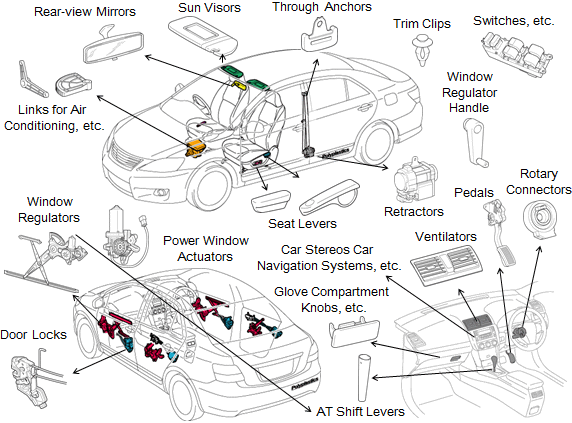Home > Products > DURACON(R) / TEPCON(R) POM
Low-VOC POM for Automotive Interiors
| DURACON® POM LV Series ━ Industry's Broadest Line of Low-VOC Polyacetal Grades for Automotive Interiors |
Introduction |
A variety of materials are utilized in automobile cabin interiors, but there is a possibility that these materials may release VOCs (Volatile Organic Compounds). As VOCs contain substances that can have a negative impact on the health of passengers, regulations governing the concentration of VOCs in automobile cabin interiors have been introduced in recent years, similarly to housing.1) There have also been moves to mitigate the release of chemical substances that have an unpleasant odor regardless of their impact on health, in order to improve the comfort of automobile passengers. A variety of substances are used in automobile cabin interiors, such as metals, plastics, fibers, leather, adhesives, paints, and lubricants. Among these, plastics are being increasingly utilized in structural and design components for the purpose of increased fuel efficiency through weight reduction, and improved formability and productivity. This trend means that the reduction of VOC generation and the elimination of unpleasant odors from plastic materials is more necessary now than ever before. Methods for reducing VOCs and odors in automobile cabin interiors can be broadly divided into two categories. The first of these is to reduce the quantity of substances responsible for the VOCs and odors released from materials, while the other is to eliminate the released substances. For example, this involves the adsorption, decomposition, and discharge of the VOCs and odors. In this report, we introduce POM─one of the plastics used in automobile cabin interiors─and explain about our efforts to reduce VOC emissions. Additionally, the URL at the end of this report links to an introduction of our Low-VOC DURACON® POM grades. Please also visit the link for more information. |
1. POM and Formaldehyde |
POM is an acronym for the chemical name polyoxymethylene. It is generally referred to as polyacetal or acetal resin. It is a crystalline thermoplastic resin primarily composed of POM is an engineering plastic that is widely used as a material in all manner of components for automobiles and electrical and electronic equipment, due to the fact that it exhibits excellent, well-balanced mechanical and chemical properties, as well as excellent cost performance. For reference, in Figure 1 we present examples of the use of Polyplastics' DURACON in automobile cabin interior components. Apart from automobile cabin interior components, POM is also used in sliding parts, such as the internal gears of in-vehicle equipment including car stereos and car navigation systems. Although POM is widely used, it can release formaldehyde─a type of VOC. Formaldehyde has an unpleasant odor and is one of the substances subject to regulations governing the concentration of VOCs in automobile cabin interiors. Therefore, it is important to reduce the level of its emissions. |
 |
| Figure 1. Examples of POM's Use in Automobile Interior Parts |
|---|
2. What is VOC? |
| 2.1. Types of POM and their Patterns of Degradation |
Figure 2 shows a diagram illustrating methods for stabilization of POM. POM is a formaldehyde polymer, but in the case of polymers consisting solely of simple formaldehyde, a degradation reaction can easily propagate from the ends of the polymer chains when ... |
|
||||||
[Reference] |
14th November 2017 |

